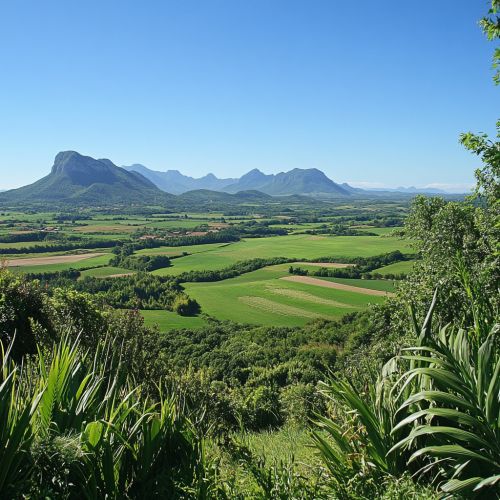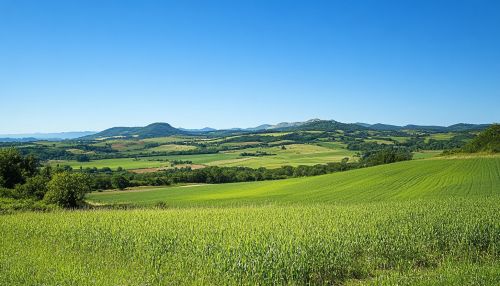Léogâne: Difference between revisions
(Created page with "== Geography and Climate == Léogâne is a commune located in the Ouest department of Haiti, approximately 29 kilometers west of the capital city, Port-au-Prince. It is situated on the northern coast of the Gulf of Gonâve, a large body of water that significantly influences the region's climate and ecology. The area is characterized by a tropical climate, with distinct wet and dry seasons. The wet season typically spans from May to October, bringing heavy r...") |
No edit summary |
||
| Line 5: | Line 5: | ||
The topography of Léogâne is predominantly flat, with fertile plains that support agriculture, one of the main economic activities in the region. The [[Momance River]] flows through the commune, providing essential water resources for both agriculture and daily life. The river is also a critical component of the local ecosystem, supporting a variety of plant and animal species. | The topography of Léogâne is predominantly flat, with fertile plains that support agriculture, one of the main economic activities in the region. The [[Momance River]] flows through the commune, providing essential water resources for both agriculture and daily life. The river is also a critical component of the local ecosystem, supporting a variety of plant and animal species. | ||
[[Image:Detail-98513.jpg|thumb|center|Scenic view of Léogâne's landscape with lush green fields and distant mountains under a clear blue sky.|class=only_on_mobile]] | |||
[[Image:Detail-98514.jpg|thumb|center|Scenic view of Léogâne's landscape with lush green fields and distant mountains under a clear blue sky.|class=only_on_desktop]] | |||
== History == | == History == | ||
Latest revision as of 15:18, 18 October 2024
Geography and Climate
Léogâne is a commune located in the Ouest department of Haiti, approximately 29 kilometers west of the capital city, Port-au-Prince. It is situated on the northern coast of the Gulf of Gonâve, a large body of water that significantly influences the region's climate and ecology. The area is characterized by a tropical climate, with distinct wet and dry seasons. The wet season typically spans from May to October, bringing heavy rainfall and occasional tropical storms, while the dry season lasts from November to April, with significantly reduced precipitation.
The topography of Léogâne is predominantly flat, with fertile plains that support agriculture, one of the main economic activities in the region. The Momance River flows through the commune, providing essential water resources for both agriculture and daily life. The river is also a critical component of the local ecosystem, supporting a variety of plant and animal species.


History
Léogâne holds a significant place in Haitian history, being one of the earliest settlements established by the Taíno people, the indigenous inhabitants of the island. The area was originally known as Yaguana, a name that reflects its pre-Columbian heritage. The arrival of Christopher Columbus in 1492 marked the beginning of European influence, leading to the eventual colonization by the Spanish and later the French.
During the colonial period, Léogâne became an important center for sugar production, driven by the labor of enslaved Africans. The economic prosperity of the region during this time was closely tied to the plantation system and the exploitation of enslaved people. The legacy of this period is still evident in the cultural and social fabric of Léogâne today.
Léogâne was also a pivotal location during the Haitian Revolution, which began in 1791 and led to the establishment of Haiti as the first independent black republic in 1804. The revolution was a complex and multifaceted struggle that involved enslaved Africans, free people of color, and European colonial powers. Léogâne's strategic location made it a site of numerous battles and skirmishes throughout the conflict.
Demographics
The population of Léogâne is diverse, with a rich tapestry of cultural influences stemming from its indigenous, African, and European heritage. The majority of the population identifies as Afro-Haitian, reflecting the historical impact of the transatlantic slave trade. The local language is predominantly Haitian Creole, although French is also widely used, especially in formal settings and education.
Léogâne has experienced significant population growth in recent decades, driven by both natural increase and migration from rural areas. This growth has placed pressure on local infrastructure and resources, leading to challenges in housing, sanitation, and public services. Despite these challenges, the community remains resilient, with strong social networks and a vibrant cultural life.
Economy
The economy of Léogâne is primarily based on agriculture, with sugarcane, bananas, and rice being the main crops cultivated in the region. The fertile plains and favorable climate provide ideal conditions for farming, and agriculture remains a vital source of employment and income for the local population. In addition to crop production, livestock farming is also practiced, with cattle, goats, and poultry being the most common animals raised.
In recent years, there has been a growing interest in diversifying the local economy, with efforts to promote small-scale manufacturing and artisanal crafts. These initiatives aim to create new employment opportunities and reduce the community's reliance on agriculture. Tourism is another potential growth area, with Léogâne's rich history and cultural heritage offering unique attractions for visitors.
Culture and Society
Léogâne is renowned for its vibrant cultural traditions, which are deeply rooted in the region's history and diverse influences. The Rara festival, a traditional Haitian celebration that takes place during the Easter season, is particularly significant in Léogâne. This colorful and energetic event features music, dance, and street processions, drawing participants and spectators from across the country.
Music and dance are integral to the cultural life of Léogâne, with Kompa and Vodou drumming being popular forms of artistic expression. These musical traditions are often accompanied by dance, with performances taking place at community gatherings, religious ceremonies, and festivals.
The practice of Vodou, a syncretic religion that combines elements of African spirituality, Catholicism, and indigenous beliefs, is also an important aspect of life in Léogâne. Vodou ceremonies, known as Lwa rituals, are held to honor the spirits and seek their guidance and protection.
Education and Health
Education in Léogâne is provided by a mix of public and private institutions, with primary and secondary schools serving the local population. Access to education has improved in recent years, but challenges remain, particularly in terms of resources and infrastructure. Efforts are ongoing to enhance educational opportunities and improve literacy rates, which are crucial for the community's development.
Healthcare services in Léogâne are delivered through a combination of public clinics, private practices, and non-governmental organizations. The 2010 Haiti earthquake had a significant impact on the region's healthcare infrastructure, leading to increased demand for medical services and support. In response, various international and local organizations have worked to rebuild and strengthen the healthcare system, focusing on areas such as maternal and child health, infectious disease prevention, and mental health support.
Challenges and Opportunities
Léogâne faces a number of challenges, including vulnerability to natural disasters, economic instability, and social inequality. The region's location makes it susceptible to hurricanes and earthquakes, which can have devastating impacts on the community. Efforts to improve disaster preparedness and resilience are critical to mitigating these risks.
Economic diversification and sustainable development are key opportunities for Léogâne's future. By investing in sectors such as tourism, manufacturing, and renewable energy, the community can create new jobs and reduce its dependence on agriculture. Additionally, initiatives to improve education and healthcare will play a vital role in enhancing the quality of life for residents and fostering long-term growth.
